This is a rarity for me, as I’m going to talk about two games instead of one, and I’ll even compare them a bit. This is because, although I beat one game, I gave up on another:
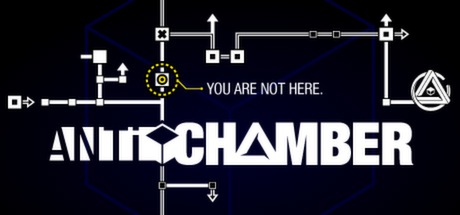
I’ve played my fair share of flawed games, and I’ve even played a few bad games. However, this is the first game where I felt actively betrayed (I’m seriously considering re-evaluating my Steam wishlist to make sure there aren’t any more games like this there). Sure, in retrospect, the game doesn’t advertise itself as a puzzle game, but that’s its most popular user-defined tag, and that’s what everyone calls the game, so you can forgive me for believing them. In reality, what the game actually is is an adventure game, but not just any kind of adventure game. Think of those old adventure games for Atari 2600 like the Swordquest trilogy or Raiders of the Lost Ark (you know, the same ones that contributed to the 1983 video game crash), but in 3D and without the instruction manual, and that’s what Antichamber is in a nutshell: few colors, few details, and extremely obtuse regarding what you need to do to progress.
Let me break down what makes a puzzle game different from other genres: in a puzzle game, you know the mechanics of the game and you know exactly where you have to go to progress, but the challenge lies in how you need to use the mechanics to get to where you need to go. In an action game, you know the how as well; the challenge lies in doing it. In this game, you don’t know where to go, and sometimes, where you need to go and what you need to do to get there are extremely unintuitive to figure out. For example, one split path will be a dead end, but another split path that looks exactly like it will just have a fake wall and actually continue the game. Seriously, how, outside of dumb luck or reading a walkthrough, was I supposed to figure out that I need to look at a symbol on the floor to trigger an invisible staircase, then climb the staircase and use my block gun to form a bridge to the reverse-staricase on the ceiling, which is actually just another fake wall? I thought that the reverse staircase was just a fancy-looking way to put a fork in the road (but maybe red flags should have been raised when I saw anything that could have been described as “fancy-looking” in this game).
By the way, fake walls will block your block gun’s shots, and invisible walls will not. Even if they did, you have to find ammunition, so it wouldn’t be a viable way of looking for secrets anyway.
Oh, and just to be mean, the game will have hints on how to progress through a part of the game right after you’ve passed the part, giving more credence to my hypothesis that you’re intended to get through most of the game by blind luck (or by reading a walkthrough).
To be fair, there are a few parts of the game that actually fit the mold of being puzzles (like when you first get the block gun), but they’re few and far between, and it’s not worth putting up with the rest of the game for them.
Obviously, I do not recommend this game. It’s one of the few games I actively decided to stop playing before I beat it. I know it’s trying to subvert player expectations, but fake walls and invisible stairs are not the way to go about this (especially when it’s done as unintuitively as this game does it). You see, having a game subvert player expectations is like putting prejudice in a game: if you’re not careful, you’re going to make a lot of people angry. I gave the game an honest chance (101 minutes according to Steam), but this isn’t the game for me, and even if you’re interested in playing a game that subverts expectations, I recommend that you play Pony Island instead.
Anyway, I wasn’t in a good mood after playing Antichamber, so I played what I knew would be a much better game:
Specifically, I played the iteration called Zook Man ZX4, and yes, I know I got the name wrong in my other post. Sorry. Bootleg names can be hard to remember.
Anyway, this is a Mega Man X styled platformer, similar to the previous two Zook Hero games (you jump, you shoot, you get boss’s weapons, mini-bosses are harder than the Mavericks, Mavericks have no discernible weakness to weapons, etc.). However, there are a few notable differences aside from the jump from GBC to GBA: there’s an intro stage (rather than having the stage select come up first), the player sprite is different (probably still stolen, though), movement is faster, rooms are larger, the player can’t slide, and the player no longer starts with the dash ability: dashing is now granted by finding the proper upgrade capsule, and even with dashing, the player can’t dash-jump, so it’s only really useful for dodging. By the way, despite the additional buttons on the GBA, dashing is still triggered by double-tapping forward; the shoulder buttons are used to cycle through the weapons you get from defeating bosses. Also, the game has eight Mavericks to choose from rather than the usual six, and two of the stages incorporate a SHMUP play-style (like Tengu Man’s stage in Mega Man 8), which I thought was neat (although the miniboss of the sky stage has a SHMUP-like attack that’s hard to avoid given the player’s hit-box).
By the way, the enemies in the game are stolen from more recognizable sources, specifically Mega Man 7, Mega Man X, and Mega Man and Bass, and the more realistic Mega Man and Bass sprites clash with the more stylized sprites that the rest of the game uses (although it was amusing to see Sniper Joes with shields that don’t work). Some of the sprites were even reused from the previous Zook Hero games (though they had a graphical upgrade).
To be honest, this game seems even more rushed than Zook Hero 2. On top of what I mentioned previously, the track that plays when you fight a mini-boss continues to play after you defeat it until you die or make it to the stage boss (as opposed to playing the stage theme again). Also, the game cycles between four different tracks for the bosses and mini-bosses, one of which is the intro stage theme (which doesn’t really work as a boss theme). Another issue is that the bottom corners of platforms lack side-collision, making it a bit finicky to make wall-jumps at times (and the controls are already a bit stiff). I actually got killed at least once because I tried to make a wall jump only to fall off the wall and into a pit. The way it handles lives is also problematic: when you die on your last life, you’re sent back to the title screen, but since the game saves how many lives you have, you’ll be sent back to the title a lot if you save with zero lives left. Luckily, the game also saves your progress at checkpoints just like the previous game did, so it’s not that big a deal.
However, I think the biggest problem with the game is how it handles spawning enemies. For example, there’s a brief part in the lava stage (second from the top-right) where you have to jump across moving platforms while avoiding Mega Man X bats. However, their positioned just above the screen when you’re on the ground, so even if you destroy them, they’ll respawn when you jump again to get on the moving platform. You see, since rooms are a bit bigger, hallways have a bit of vertical scrolling to them as well, so when the screen scrolls back up, their spawn point is back on screen again and another bat spawns. It’s quite annoying.
Speaking of enemy spawning, there were two instances where, after the protagonist teleports into the level, I’d go left a bit first before going right, and when I killed an enemy, the explosion would be somewhere else on the screen and I’d get stuck and have to reset the game.
Something else I feel should be mentioned: even though this is a GBA game, it still only uses GBC instruments; sound effects will even cancel out certain instruments. As a side note, some of the music in this game was reused from Super Fighter 2001 Alpha and Soul Falchion (which I haven’t played because I’m not a big fan of fighting games), although that’s a common occurrence with bootlegs. Speaking of music: normally, the music in the Zook trilogy is pretty good, but the stage select/weapon get song in this game is really annoying. Luckily, it’s a short part of the game.
And now, a list of other issues I had with the game:
- This enemy type gets stuck on ladders, which is a problem when I have to go up:

- Mini-bosses are programmed to appear instantly:

- These enemies blend in too well to the scenery to be invulnerable while idle (especially when there are other enemies around):
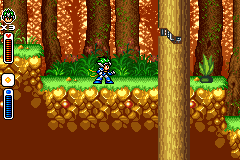
- Here’s another example of the game being cheap: if you don’t have any weapon besides the default, you can’t get past without getting hurt.

- In this boss room (and only in this boss room), you’re not allowed to wall-jump up the entire wall for some reason, making it difficult to jump over the boss for this one part:

- Similar to the issue with bottom corners, the sides of ladders also lack collision when they’re on the edge of platforms:
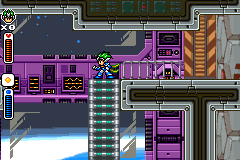
- Lastly, since the player can’t dash-jump, this part can’t be passed without taking a hit:

Oh, and before I forget, I should mention one more difference between this game and its prequel: armor pieces aren’t behind destructible walls in this game; they’re just placed out in the open, only slightly in the opposite direction of the main path. Because of this, they’re much easier to obtain, and I was able to get all of them before beating all the Mavericks (so I’m not sure if they’re required for progression, but given the previous game, they probably are). Also, unlike the previous games, the game starts off with spikes not instantly killing the player, so the helmet armor (presumably) does nothing.
Actually, there is one armor piece that isn’t just out in the open. It’s hidden behind…a fake wall…
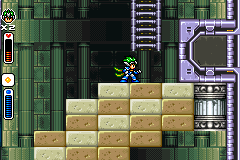
and you know what? I still think this game handled it better than Antichamber. Sure, this is literally the only time the game does something like it (as far as I know), but it establishes that there’s a way down there by letting you see the capsule when you enter the room:

Sure, Antichamber has a map that lets you know where an unexplored path is, but it isn’t uncommon for you not to know how to access said path or even in which direction the unexplored path is. You might not even be able to access said path yet, or maybe said path will just be another loop that accomplishes nothing. There’s barely anything consistent with the game. For a non-wall example, green blocks respawn when absorbed by the block gun, but there’s one part with twelve green blocks in corner formation, and if you absorb them, they stay absorbed like regular blue blocks. In my opinion, two of the things a game needs in order to be fun are 1) consistent mechanics and 2) intuitive design. Sure, Zook Man ZX4 was inconsistent by having a random fake wall in between the main path and an armor piece, but it intuitively established that the armor piece was down there, meaning there was a way to get it (similar to how Adventures of Pip does with some of its captured citizens).
Anyway, when you beat all eight Mavericks, the z stage becomes available, just like in the prequel. However, rather than have the capsule transports at the end, it starts off by reusing the graphics and stage theme of the top-left stage, then shortly afterward, you have to fight the top-left boss again. It does this for all eight bosses (so you don’t get to choose the order you re-fight the bosses in, similar to the original Mega Man or the first Mega Man X), and then the credits roll. Yup, no unique final boss, or even a unique final stage. Also, the credits reuse the theme from the castle level (the one with the fake wall), and it doesn’t work as a credits theme.
Overall, just like the prequel, I can’t recommend this game, but I still preferred it to Antichamber. Honestly, I think I had more fun with this game because I played it after Antichamber, and, you know, Antichamber is a game about putting things into perspective (at least, that’s how it came across to me), so in a way, maybe it did its job.
Okay so to be clear, you don’t recommend Antichamber? :p
So I played this game a long time ago (prior to joining Steamgifts) and while I kind of know what you mean and what you’re saying, for the most part I didn’t have a problem with “figuring out what the puzzle was” as being a valid part of the puzzle itself. Yuck, horrible sentence…please ignore. And I didn’t mind it trying to trick you, and things changing after subtle events, etc. Yes, it’s a big game of mindf–ks, but I personally didn’t think that made it a bad game…just one that’s not for everyone. But keep in mind– it does have an Overwhelmingly Positive overall rating…it can’t be that bad, can it? That said, after a couple of hours, I did kind of abandon it, which isn’t something I do often. So I guess I got tired of it too.
[Edit: I like the one quote by a reviewer: “Every aspect of Antichamber is designed to get players out of their comfort zone.” Tis true!]
It’s like reading my own analysis about antichamber. It was in my wishlist, and I purchased it and played it before joining BLAEO. And it was an abysmal experience. I would describe it the same as you, and I totally hated it. It’s one of the few games in my “crap games” list, outside the ones that didn’t work for me. I felt so cheated.
Spot on assessment of antichamber to be honest. I also thought it looked like the type of mind warp I enjoy. Subverting your expectations and throwing some puzzles at you, but in the end it felt a bit like one of those childhood games the class idiot would throw out demanding that you guess exactly what they are thinking of, without offering too much in the way of hints, other than to tell you you’re wrong. So it was great as a demonstration of what you have the freedom to do in a game, it was terrible as an actual game. I think games like the aforementioned Pony Island, The stanley parable and Dr langeskov do a much better job of the old ‘bait and switch’ as a commentary on games.
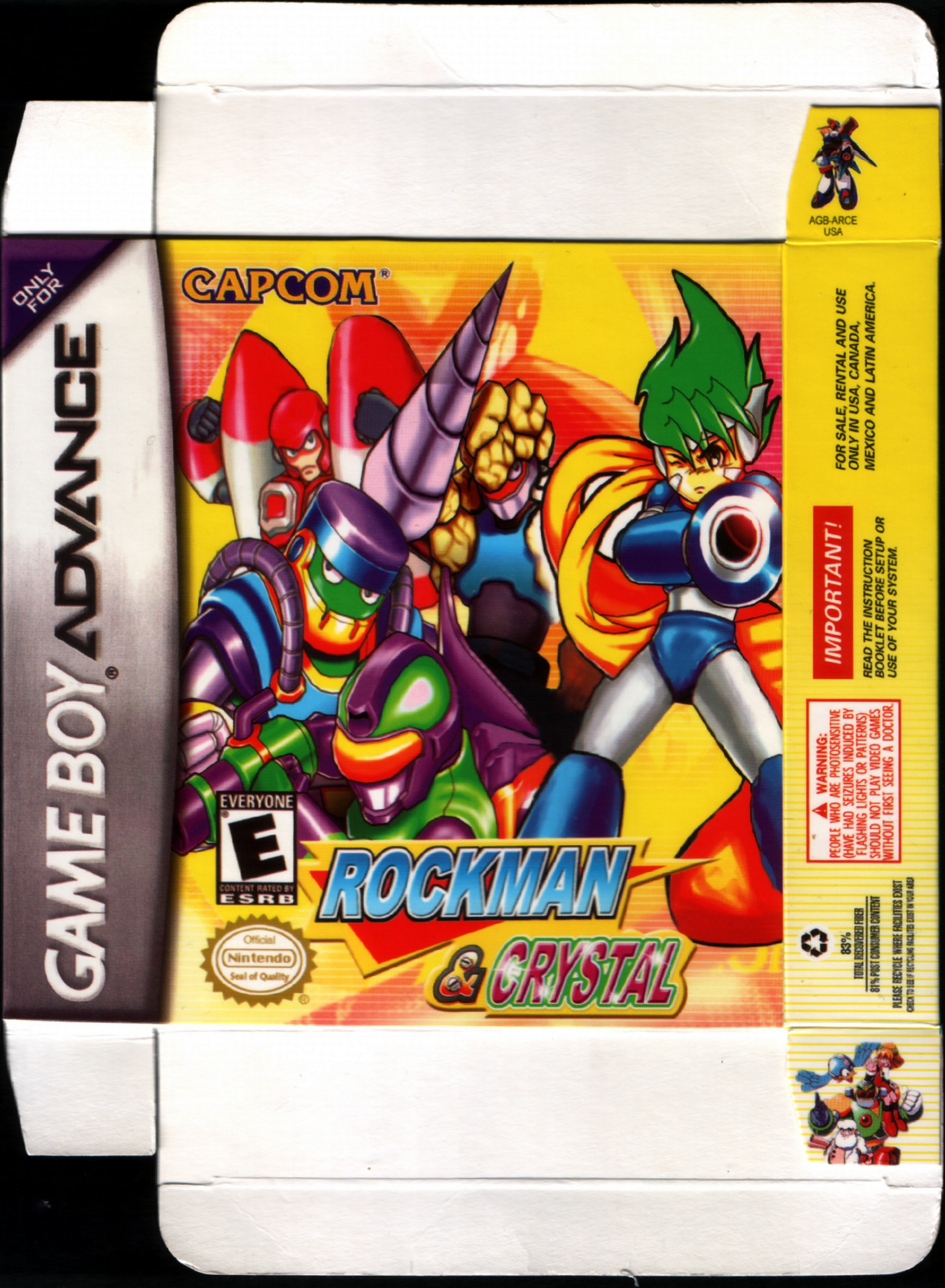
dang Antichamber is on my wishlist. I may just reconsider having it now.
Congrats on your completions and good luck finding some you like next time!
Don’t be dissuaded! It does have an Overwhelmingly Positive overall rating…it can’t be that bad, can it? But it’s not for everyone, and you have to be willing to hit your head against a wall sometimes, and be taken out of your gaming comfort zone.